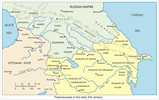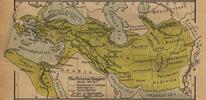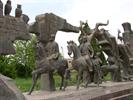Black sheep, white sheep and the great Azeri Empire
Following Timur's death in 1404, one of these Turkmen groups (the Shi'ite Qarakoyunlu - 'Black Sheep') fought a coalition of 'traditional' lords for control of southern Azerbaijan, only to be ousted by another (the Sunni Aqkoyunlu - 'White Sheep') in the late 1460s. The Aqkoyunlu then spent much of the century squabbling with the Ottoman Turks who by this stage had occupied Anatolia and were growing increasingly into a regional power. Throughout this period the smaller Azeri sub-khanates continued to fight amongst themselves, notably Shirvan versus Ardebil. In 1456 there was a major battle at Hazra on the Samur River, where amongst the Ardebil leaders to die was a certain Sheikh Juneid. In 1500, Juneid's grandson Ismail set out to avenge his death, as the improbable 14-year-old leader of the Ardebil army. Following a remarkable run of success, he found himself rapidly propelled to ruler of all Azerbaijan eventually becoming Shah Ismail I of Persia (Iran). His Safavid dynasty is remembered for forcing the Persian empire to definitively embrace Shi'ite rather than Sunni Muslim traditions.
In Azerbaijan, Ismail is generally remembered by his poetic pen name Xatai under which he popularized Azeri as a written language of arts and letters. He wrote everything from love ballads and seasonal odes to works on philosophy and morals, but perhaps most interesting are the surprisingly self-deprecating little verses he wrote to himself as apparent reminders of good government or behaviour
Xata's of a pedant's school
Sufi by heart and should know much
Yet tell the truth I'm but a fool
With all that business puts in train
Remember Xatai, to be restrained
Bite off more than you can chew
And little of friendship will remain
Later Safavids
Throughout the 16th century, wars raged between Safavid Persia and Ottoman Turkey. The later Safavid shahs lost touch with their Azeri roots, moving the capital from Tabriz via Qazvin to the safety of Isfahan, a glorious new city in central Iran, far from the ravages of interminable wars with the Ottomans.
To provide the necessary skilled expertise for this, Shah Abbas I simply dragged away the entire artisan population of Old Julfa and resettled them outside Isfahan Shirvan (centred on Shamakha), Karabagh (administered from Ganja) and Nakhchivan (aka Shukur-Saada) retained some identity as bekleihek-lik regions within Safavid Persia.
In 1580, the Ottoman Turks occupied Shirvan in an unlikely coalition with Crimean Tatars and Caucasian mountain tribes. This was an economic disaster for Azerbaijan which had been rebuilding itself as a north-south trade route. A splendid if long out-of-print account of the period was written by a group of swashbuckling Elizabethan English wool traders who got caught in the middle.
The Khanates
From 1708 Iran's Safavid Shahs were increasingly distracted by infighting and were overthrown altogether in 1722. Peter the Great of newly-expanding Russia took the opportunity to occupy much of Azerbaijan and the Caspian coast but was chased out by a new breed of Persian ruler - the Afghan-descended Nadir Shah.
As his apt name coincidentally suggests, Nadir's brutal arrival was the lowest ebb for some Caucasian fortunes since the rampages of Timur. Nadir was assassinated in 1747 which was the cue for a confederation of Azeri khans to drive out the Persian governors altogether. The result was a renewed blossoming of Azeri culture, notably in Ganja and under Panakh Khan in Karabagh where Shusha became Azerbaijan's cultural capital par excellence. There was the usual cycle of jostling for superiority between the several regional power centres (see Khanate map), with Shaki under Haci Saleb an initial front runner. Latterly Fatali Khan of Quba attempted to unite the regions into a single Azeri state. The enterprise was inevitably interrupted by incursions from Persia and Russia.
In 1795, the last year of Catherine the Great's rule, Russian expeditionary troops marched into Azerbaijan, took Shamakha and might have gone further but for the simultaneous northward march of a great Persian army. Iran was newly rampant under the vicious Qajar dynasty of the 'eunuch-king' Aga Mohammad, while for the next few years Russia was governed by mad Tsar Paul. However, once Paul had been conveniently murdered in 1801, the Russians returned to the Caucasus in force, initially occupying Georgia then whittling away at the Azeri khanates (1804 to 1806).
If you're planning a trip to Azerbaijan: Check The latest information of visa regime in Azerbaijan. Please do not hesitate to contact us for consultation.









